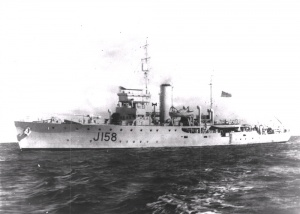HMAS Bathurst (I) was the first of 60 Australian Minesweepers (commonly known as corvettes) built during the Second World War in Australian shipyards as part of the Commonwealth Government's wartime shipbuilding program. Twenty (including Bathurst) were built on Admiralty order but manned and commissioned by the Royal Australian Navy. Thirty-six were built for the Royal Australian Navy and four for the Royal Indian Navy.
HMAS Bathurst (I) was laid down at Cockatoo Docks and Engineering Co Ltd, Sydney, New South Wales on 10 February 1940. It was the first RAN warship to carry the name of the regional city in the central tablelands of New South Wales, located 200 kilometres north-west of Sydney. It was launched on 1 August 1940 by Mrs Doyle, wife of the Engineer Manager, Garden Island Dockyard.
HMAS Bathurst (I) commissioned at Sydney on 6 December 1940 under the command of Lieutenant Commander AV Bunyan RANR(S).
Bathurst began its career in January 1941 as a unit of the 21st Minesweeping Flotilla (RAN), operating on the east Australian coast. In March 1941 it left Australian waters for Malaya, where it operated as a patrol vessel based on Singapore until 26 May 1941.
On 3 June 1941 it arrived at Colombo and there joined the Eastern Fleet for escort and patrol duties. At the close of June, Bathurst entered the Red Sea, spending a month in those waters before docking at Alexandria on 4 August 1941.
On 25 August 1941 Bathurst returned to Aden, and then began a period of three and a half months on patrol in the Gulf of Tajura (French Somaliland), with the mission of preventing dhow traffic and blockade maintenance of the African coast. On 18 October 1941 it captured the French launch Heron, and dhows on 5 September and 14 November 1941.
Red Sea patrols ended on 16 December when Bathurst proceeded to Colombo, arriving on 29 December. Throughout 1942 it was based on Colombo for escort and patrol duties in the Indian Ocean, Persian Gulf and Arabian Sea. On 18 October 1942 Lieutenant Commander Bunyan was relieved by Lieutenant Commander C MacDonald RANR(S), after almost two years in command. At this stage of its career Bathurst had steamed 70 000 miles and escorted more than 1 000 000 tons of shipping without loss.
Convoys between Mumbai, the Persian Gulf and Aden kept Bathurst almost constantly at sea during the period of January to August 1943. Interspersed with antisubmarine patrols it escorted 28 convoys safely across the Arabian Sea.
In September 1943, with 102 000 miles steaming behind its, it began refitting at Colombo. Convoy escort duty between Colombo and Mumbai resumed in November, and the year closed with Bathurst at sea en route for Kolkata.
Escort duty between Colombo to Mumbai continued into 1944. At Mumbai on 14 April Bathurst played a worthy role in the rescue and salvage work that followed the explosion of the munition ships Fort Strikine and Jalapadma. Fifteen ships were gutted by the resulting fires and large numbers of the local population killed and injured.
On 7 August 1944 Bathurst reached Colombo after escorting its last Indian Ocean convoy. Three weeks later, on 29 August, it sailed for Australia, ending almost 3½ years Indian Ocean-Red Sea service. On 20 September 1944 it entered Fremantle harbour.
Australian coastal antisubmarine patrols kept Bathurst in home waters until April 1945 when it proceeded to New Guinea waters. At this stage of the Pacific War, with the Philippines in American hands, there remained only routine patrols for its until the end of hostilities in August 1945.
The war ended, Bathurst proceeded to the Far East as a unit of the 21st Minesweeping Flotilla (11 Australian minesweepers) attached to the British Pacific Fleet. Based on Hong Kong the Flotilla carried out sweeping operations on the Chinese coast until mid-November 1945.
On 9 December 1945 HMAS Bathurst (I) returned to Sydney, bringing its seagoing career to an end. It had steamed 160 165 miles. On 27 September 1946 it was placed in Reserve for disposal. HMAS Bathurst (I) was sold on 21 June 1948 to T Carr and Co of Sydney as scrap.

